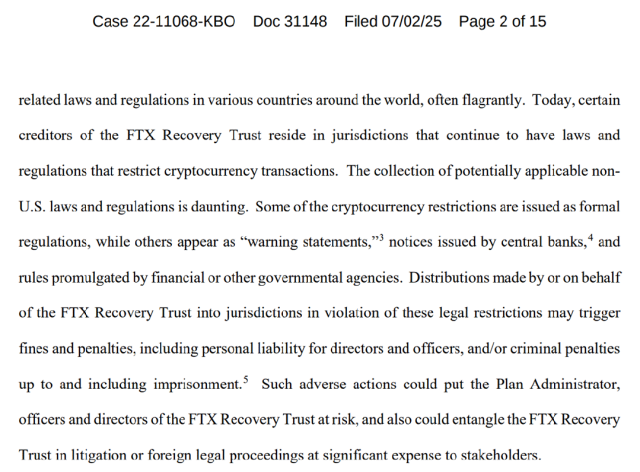撰文:桂若飞 Lucius

“Mt.Gox 与 Celsius 案的司法经验已为中国债权人在 FTX 案中争取索赔权利提供了有利参照与实务背书。尽管当前 FTX 动议路径具有封闭性与排他性倾向,但在破产法院仍保有裁量空间,中国债权人只要行动得当,仍有希望实现权利确认与赔付落地。”
2025 年 7 月 2 日,FTX 破产信托(FTX Recovery Trust)向美国特拉华州破产法院提交《在潜在受限司法管辖区实施受限处理程序的动议》,要求对 49 个司法管辖区(其中包括中国)的债权人建立差异化赔付机制。该动议核心内容可以概括为:若信托方聘请的当地律师认定向某司法管辖区付款违反当地加密监管法规,则该地区债权人债权将转为“争议债权”,最终可能被完全剥夺受偿权,并由 FTX 破产信托接管。
据相关统计,中国债权人持有 3.8 亿美元债权,约占受限地区债权总额的 82%。这一动议也在 Web3 领域及加密行业法律实务界引发了广泛关注,原因不仅在于其关系到数十万名中国投资者的索赔权利,也可能对未来全球加密企业在跨境破产中的法律适用、用户保护边界和合规路径产生深远影响。
本文拟从动议制度、法律适用以及类案分析三个维度出发,深入分析该动议所涉问题以及中国债权人的维权现状。
一、动议制度简介以及本案动议内容简析
在分析关于该动议的相关争议前,有必要首先介绍一下美国破产程序中“动议制度”(Motion Practice)的基本机制。美国破产法下的动议,是指债务人、债权人或其他利害关系人就特定程序事项或实体请求向破产法院提出的正式申请。其法律依据通常为《联邦破产程序规则》(Federal Rules of Bankruptcy Procedure),并辅以具体地方法院规则加以执行。
在《联邦破产程序规则》第 11 章中,动议可能涵盖范围极广,从资产处置、债权确认、优先受偿顺序,到如本案所示的债权人受偿资格否认,皆可通过动议程序启动。动议通常需提交正式书面文件(Motion Brief),阐明其法律依据与事实主张,并需提供相关证据支持。对于涉及重大程序权利的动议,破产法院通常还会安排听证(Hearing),听取相关方意见后,审查程序是否合规、动议主张是否成立,再作判决。换言之,动议制度构成了美国破产程序的重要组成部分,也是破产参与人推动自身利益诉求的重要工具。
回到本案,FTX 破产信托援引《美国破产法》第 105(a) 条(法院拥有发布必要命令的权力)、第 1142(b) 条(重整计划执行授权)及联邦破产程序规则第 3020(d) 条,请求法院授权信托执行“受限司法辖区处理程序”( Restricted Jurisdiction Procedures)。该动议主张拒绝向动议附件 B 中列明 49 个“潜在受限司法管辖区”的申报债权人进行赔付,其中就包括中国、俄罗斯、埃及、尼日利亚等国家。FTX 破产信托在该动议中给出理由是上述司法辖区的加密监管政策可能导致相关罚款或处罚(Fines and Penalties),阻碍债务人赔付合法性的同时可能导致相关主管人员面临刑事风险(Criminal Penalties)

(上图为 FTX 破产信托所提出动议的部分原文,解释了该动议提出的主要原因)
该动议引发的实质性问题不仅在于美国法是否允许排除特定债权人的受偿权利,更在于法院是否有权因债权人来自“受限国家”而否定其索赔资格,从而涉及等多个层面的复杂争议,下文中将从实体法和程序法两个层面展开进行详细分析。
二、法律适用范围与争议焦点:程序与实体
从实体法角度来看,本案中 FTX 破产信托提出动议援引的核心抗辩理由是“向受限制司法管辖区的用户赔付可能违反当地加密资产及外汇管制法规”。该主张从表面上看属于破产管理人“合规风险管理”的范畴,实质上却在法律适用和解释层面存在至少两重明显瑕疵:
首先,FTX 破产管理人所提出动议逻辑混淆了支付工具与赔付资产的性质。FTX 拟用于赔付的对象并非加密资产,而是美元或由法院批准的稳定币(如 USDC、USDP 等),而这类支付方式在国际支付体系中并不直接受限。类似的成功可见于 Celsius 与 Mt.Gox 破产清算案,上述两个案件的破产管理人均在法院监督下,通过 SWIFT 国际电汇或稳定币转账向位于受限司法辖区(如中国、俄罗斯)的个人债权人支付了清偿款,相关司法辖区的法院未就支付行为本身提出合规豁免要求,也并未引发相关的监管争议。
其次,该动议对中国法律、行政法规的立即和适用有误。在中国现行法律框架中,并未直接对个人持有加密资产或接收境外加密资产支付做出全面禁止。2017 年 9 月 4 日由央行等七部委发布的《关于防范代币发行融资风险的公告》重点在于限制金融机构与 ICO 平台参与代币发行和交易;而 2021 年 9 月由中国人民银行等十部委的《关于进一步防范和处置虚拟货币交易炒作风险的通知》虽进一步强化对交易平台的打击,但同样未否定个人被动接收或持有加密资产的合法性。更为关键的是,多地民事法院在部分司法实践中已承认加密资产(如 BTC、USDT 等)具备“网络虚拟财产”的地位,适用《民法典》第 127 条保护范围,可作为债权执行对象得到保护,在刑事领域也是如此。因此,该动议对中国监管政策的解释既不具备普遍约束力,也与实务判例的发展趋势相背离。
而从程序法角度来看,FTX 破产信托提出动议提出的程序安排仍有许多值得商榷之处。
FTX 的这一动议虽形式上遵循美国破产法院程序规则,但实质上却引入了一套由其主导、在操作层面较为封闭的“合规审查机制”。具体而言,FTX 破产信托方通过单方面聘请律师,就特定司法辖区的合规风险出具是否可赔付的法律意见(Legal Opinion),并且要求该意见必须为“无例外、无条件”的无保留意见(Unqualified Legal Opinion)方可接受。一旦某一国家或地区的律师认为支付可能存在法律障碍,或无法出具绝对无保留意见,则该地区所有债权将自动被列入“争议债权”(Disputed Claims),暂停赔付甚至完全剥夺索赔资格。这种审查机制在监管模糊或政策不透明的地区(如中国)尤其容易引发实质不公。例如,在中国目前尚无任何明确法律禁止个人接收美元清偿款项或持有稳定币的前提下,当地律师基于“风险无法判断”的因素考虑,也很难出具绝对肯定性的法律意见。实务上,大部分律师即使主观上倾向认为合规风险有限,基于职业谨慎义务仍会在意见中加入保留条款,由此导致“不可接受意见”(Unacceptable Opinion)成为程序上的默认结果。
更为严重的问题在于,这一合规审查机制本身并非由法院中立设立、推进,而是完全由 FTX 破产信托一方掌控,从律师选任、指令发出,到法律意见书内容设定、解释与适用,均由债务人单方控制。这种“预先设定结论,再出具法律意见进行论证”的审查机制,颇有一种“先射箭后画靶”的意味。进一步来说,这一程序设计也并未经过法院本身的实体审查程序,若法院仅基于债务人提交的法律意见内容而直接采信动议请求,实质上相当于将部分国家债权人的受偿权决定权转交给债务人控制的法律顾问。这种程序设计与美国破产法强调的“公平对待同类债权人”核心原则背道而驰,也将使中国等特定司法辖区的债权人处于系统性的不利地位。
除此之外,本文中的管辖问题同样存在争议。美国破产法院作为属地主义法院,其司法权通常限于美国破产债务人及其资产,但 FTX 的客户基础具有高度全球化特征,其平台债权构成并非单一美国法律关系,其中包含复杂的跨国合同法元素。多数中国债权人虽通过 FTX 国际平台完成账户开立,但并未明确同意适用美国法或接受美国法院进行专属管辖。因此,是否可由单一法域法院以政策性因素全盘排除特定国家用户的债权资格,在法律适用上仍存争议。而根据国际私法的一般原则,破产程序虽具有集中清算效果,但仍不得任意剥夺外国债权人正当索赔权,否则可能违反《海牙国际合同法院选择公约》《UNCITRAL 跨境破产示范法》等国际法精神。若美国法院将“合规风险”作为普遍适用的动议依据,未来在跨境破产案件中可能为其他债务人仿效,从进一步而削弱境外债权人的法律地位。
三、类似案例横向对比研究
FTX 案并非加密行业首次面临大型平台破产所引发的跨境债权清偿争议。从过往经验来看,日本 Mt.Gox 案与美国的 Celsius 案可作为本案的典型对照。两案虽分属不同法域,监管态度亦有差异,但其共同特点在于均涉及大规模跨境债权人、巨额加密资产清算,以及对中国用户权益的实质影响。这些案件中法院的处理路径、信托人角色与清偿原则,构成 FTX 案进行类比分析的重要参考。
(一)Mt.Gox 案
Mt.Gox 是比特币历史上最具代表性的交易平台破产案例之一。2014 年,Mt.Gox 因交易系统漏洞及大规模 BTC 失窃宣布破产,债权人总数超过两万,分布全球各地,其中中国债权人占据显著比例。该案受日本东京地方法院管辖,适用日本《破产法》与后期启动的《民事再生程序》。在程序设计上,法院未以用户国籍或监管风险为理由设定任何限制性门槛,反而通过“债权人门户系统”统一收集全球债权人申报请求,并支持包括中文、英文等多语种界面,进一步降低程序壁垒。
更关键的是,日本法院要求受托人基于资产实际结构提出“等比例赔付 + 剩余资产 BTC 实物返还”方案,并不区分债权人来源国家是否对虚拟货币持监管保守立场。例如在中国,尽管其时已发布《关于防范代币发行融资风险的公告》但并未影响中国用户的债权审查与赔付进度。整个程序在东京地方法院主导下保持高度司法中立性与公开性,且受托人定期发布多语种进展公告、答复集体异议。最终,绝大多数债权人得以通过 JPY、电汇或 BTC 等方式获得清偿。Mt.Gox 破产案表明,即便在复杂跨境背景下,只要法院主导程序公正、适用统一赔偿标准,加密资产的监管复杂性并不构成禁止或限制外部债权人清偿的充分理由。
(二)Celsius 案
Celsius Network 作为美国最大的加密借贷平台之一,于 2022 年申请破产重整,由纽约南区破产法院受理,适用《破产法》第 11 章。在此案中,Celsius 与 FTX 一样面临大量跨境债权人,尤其在亚洲、欧洲等地有广泛用户基础。
在具体程序安排上,破产法院与清算公司(Celsius Creditor Recovery Corporation)建立债权人门户系统,向全球开放债权申报,系统支持多语言操作,并允许债权人自行选择清偿方式,包括美元稳定币或等值比特币、以太坊。值得关注的是,Celsius 案件中并未试图通过动议方式排除任何特定国家的债权人也未设立“受限司法区”名单。对于 Celsius 案件中的中国用户而言,尽管中国政府对虚拟货币监管政策十分严格,但法纽约南区院并未采纳“潜在合规障碍”或“外汇管制”作为排除或冻结中国债权人清偿权的依据。
更重要的是,法院在判决中坚持破产法下债权人平等受偿的基本原则,并明确指出除非法律上有明确禁止或外国法院提出协助请求,否则不得因监管模糊而单方面否定外国债权人权利。事实上,包括 Celsius 案中大量中国大陆用户在内的债权人均已于 2024 年初完成初步赔付,多数通过第三方 KYC 审核平台完成身份验证,并获得 USDC 转账或相应 BTC 分配款项,这也显示法院坚持实质审查与程序保障双轨并行的处理逻辑。
综合 Mt.Gox 与 Celsius 两个先例可见,在司法主导性强、程序规则公开透明的破产处理机制中,尽管债权人所处国家存在加密资产监管模糊或外汇限制,法院仍倾向于维护债权人基本民事权利,主张“非歧视性参与”原则,这对中国债权人在 FTX 案中的维权路径具有重要参考价值。
首先,从司法理念层面看,无论是日本法院在 Mt.Gox 案中对中国债权人开放申报渠道、支持本币赔付选项,还是美国纽约破产法院在 Celsius 案中明确拒绝以“监管不确定性”否定中国债权申报资格,都说明现代法院在处理跨境加密破产案件时,更加注重实质审查与债权人平等参与权的保障。特别是 Celsius 案中,美国法院在面对中国大陆等地区用户时,并未援引任何一国监管为理由排除赔付,而是通过 KYC 与身份认证等程序性工具实现了风控与合规平衡。
其次,从破产法院的裁量机制看,美国破产程序虽赋予债务人一定动议权与程序设计空间,但最终仍需破产法院对动议进行实质性审查。结合 FTX 案当前的程序走向——包括已提交的中国债权人代表反对意见、全球债权人社区的广泛抗议——可以合理预期,法院未必会无条件采纳 FTX 破产信托关于“排除受限制司法辖区债权人”的动议主张,而可能倾向采取更加细化、按地区进行单独处理的裁判方式。在此背景下,中国债权人如能通过律师组织集体行动、正式提交反对动议并积极参与听证程序,其债权仍有希望获得法院承认与清偿的。
当然,维权最终结果仍取决于法院最终如何平衡“合规障碍”与“程序平等”、“部分债权人”和“全体债权人”之间的冲突。一旦法院采纳 FTX 的动议逻辑,则中国债权人或需进一步提起上诉或通过外交渠道争取修正程序。
综上所述,Mt.Gox 与 Celsius 案的司法经验已为中国债权人在 FTX 案中争取索赔权利提供了有利参照与实务背书。尽管当前 FTX 动议路径具有封闭性与排他性倾向,但在破产法院仍保有裁量空间,中国债权人只要行动得当,仍有希望实现权利确认与赔付落地。
免责声明:本文章仅代表作者个人观点,不代表本平台的立场和观点。本文章仅供信息分享,不构成对任何人的任何投资建议。用户与作者之间的任何争议,与本平台无关。如网页中刊载的文章或图片涉及侵权,请提供相关的权利证明和身份证明发送邮件到support@aicoin.com,本平台相关工作人员将会进行核查。




